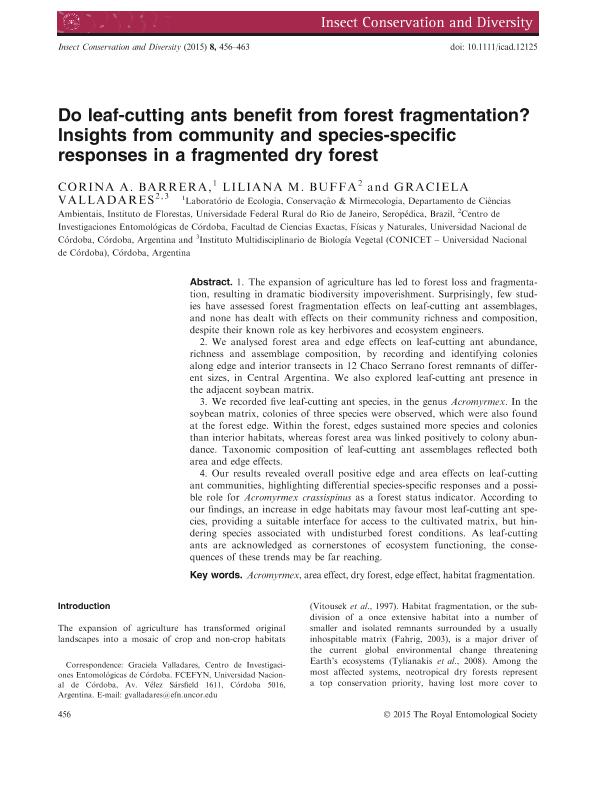Artículo
Do leaf-cutting ants benefit from forest fragmentation? Insights from community and species-specific responses in a fragmented dry forest
Fecha de publicación:
03/2015
Editorial:
Wiley-liss, Div John Wiley & Sons Inc
Revista:
Insect Conservation And Diversity
ISSN:
1752-458X
Idioma:
Inglés
Tipo de recurso:
Artículo publicado
Clasificación temática:
Resumen
1.The expansion of agriculture has led to forest loss and fragmentation, resulting in dramatic biodiversity impoverishment. Surprisingly few studies have assessed forest fragmentation effects on leaf-cutting ant assemblages, and none has dealt with effects on their community richness and composition, despite their known role as key herbivores and ecosystem engineers. 2.We analyzed forest area and edge effects on leaf-cutting ant abundance, richness and assemblage composition, by recording and identifying colonies along edge and interior transects in twelve Chaco Serrano forest remnants of different sizes, in Central Argentina. We also explored leaf-cutting ant presence in the adjacent soybean matrix. 3.We recorded five leaf-cutting ant species, in the genus Acromyrmex. In the soybean matrix, colonies of three species were observed, which were also found at the forest edge. Within the forest, edges sustained more species and colonies than interior habitats, whereas forest area was linked positively to colony abundance. Taxonomic composition of leaf-cutting ant assemblages reflected both area and edge effects.4.Our results revealed overall positive edge and area effects on leaf-cutting ant communities, highlighting differential species-specific responses and a possible role for A. crassispinus as a forest status indicator. According to our findings, an increase in edge habitats may favor most leaf-cutting ant species, providing a suitable interface for access to the cultivated matrix, but hindering species associated with undisturbed forest conditions. Since leaf-cutting ants are acknowledged as cornerstones of ecosystem functioning, the consequences of these trends may be far reaching.
Palabras clave:
Acromymex
,
Dry Forest
,
Edge Effect
,
Habitat Fragmentation
Archivos asociados
Licencia
Identificadores
Colecciones
Articulos(IMBIV)
Articulos de INST.MULTIDISCIPL.DE BIOLOGIA VEGETAL (P)
Articulos de INST.MULTIDISCIPL.DE BIOLOGIA VEGETAL (P)
Citación
Barrera, Corina A.; Buffa, Liliana M.; Valladares, Graciela Rosa; Do leaf-cutting ants benefit from forest fragmentation? Insights from community and species-specific responses in a fragmented dry forest; Wiley-liss, Div John Wiley & Sons Inc; Insect Conservation And Diversity; 8; 3-2015; 456-463
Compartir
Altmétricas




